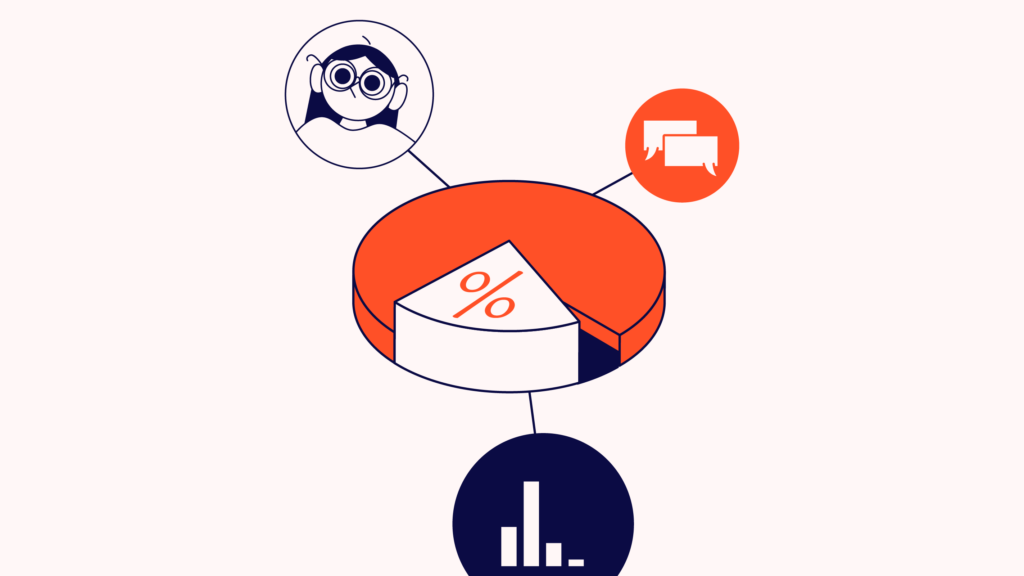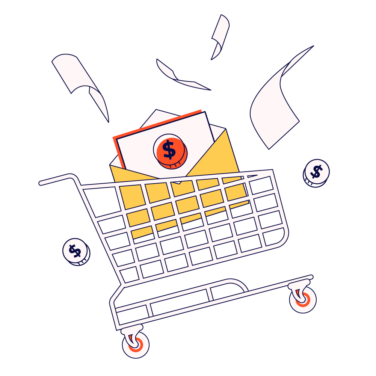Ecommerce personalization trends are constantly evolving—and they matter more than ever in a saturated digital market.
Despite the consistent expansion of retail sales worldwide, the ecommerce market growth rate has recently slowed down compared to its surge during the pandemic years. Forecasts from Insider Intelligence support this trend, indicating a reduction of online sales in global trade share from 10.4 percent in 2023 to 9.6 percent in 2024.
As a result of these shifts, many retailers are reconsidering their business strategies. Some focus on novel approaches. Others stick to time-tested trends, among which ecommerce personalization is the most effective omnichannel marketing strategy.
In this article, I will share my insights about ecommerce personalization trends for 2023 and beyond. Read further to be among those brands that will attract success within the demanding conditions of the ecommerce sphere.
What Is Ecommerce Personalization?
Personalization—tailoring messages and products to specific consumers—is a highly appealing sales-boosting strategy. A whopping 74% of online shoppers express frustration when they witness relevant content not adapted to their needs, and nearly 80% choose to buy from specific outlets where they receive personalized product recommendations or individualized treatment.
Stick to user experience personalization seasoned with awareness campaigns targeting a broad audience if you wish to bolster your sales performance and consumer appeal.
Choosing between two brands offering similar products, buyers will invariably turn to one that consistently adjusts its products and services to match their preferences and needs. Full brand maturity in personalization happens when every customer receives a distinct recommendation score. It should correlate with their browsing history, previous purchases and return habits, and data from paid campaigns.
Furthermore, a quarter of retailers see potential in adopting technologies that support hyper-personalization. Implementing a seamless checkout process increases conversion rates, enabling the sale of more products at higher prices and yields valuable customer data that benefit the entire business.
The widespread adoption of smartphones has created a demand for rapid access to information. Incorporating QR Codes in marketing campaigns enables instant information delivery, elevating the customer experience and allowing real-time campaign effectiveness analysis. Marketers can retarget customers and create personalized campaigns based on these insights.
Retailers can better understand customer preferences and predict their behaviors using advanced analytical tools, segmentation, and recommendation systems. Consequently, ecommerce websites start providing products and services that better meet market expectations.
Effective personalization efforts greatly enhance customer loyalty and brand experience, ultimately improving business value.
How Can You Use Personalization To Stand Out?
In 2023, both customers and sellers are well-versed in the benefits of ecommerce. Experienced service providers face demanding users who have adapted to advanced mobile applications. Online shopping stores have yet to accommodate the full potential of mobile shopping. Most of them have already integrated a personalized shopping experience, which forms a recipe for success.
We can see that it's now commonplace to address customers by name, send personalized emails to verified email addresses, and run remarketing campaigns tailored to consumer needs. Emerging online retailers must primarily enhance customer service quality to differentiate themselves from competitors offering similar prices and client treatment. But what does this mean in practice?
Below you will see that implementing personalization strategies is relatively easy, and the potential benefits could significantly boost your profits. It's crucial to harness this potential swiftly and effectively.
Here is what is essential to keep in mind when targeting the heart of the consumer.
Engage with the audience
The simplest yet highly effective method of personalization is using the company's contact details in marketing communication. Writing newsletters and mailings, remember to address recipients by name and provide them with single case-adjusted information. Recipients will appreciate updates about products they've shown interest in, instructional materials for purchased items, or discounts on future takes.
Push notifications (both in mobile browsers and apps) should be tailored to the recipient's stage in the sales funnel. Text messages and SMS marketing are excellent ways to reach consumers aged 40 and over. Thus, companies targeting this demographic group should consider it.
Regardless of the communication channel, the cardinal rule is personalization—bulk messaging doesn't yield the desired results. 52% of customers expect consistent individual email marketing communication and recognition, even if it is their first-time contact. Remember to provide them with the coherent, personalized experience they deserve.
Stay ahead of the curve
Pop-up messaging tools and alerts enable you to reach a customer who has previously interacted with your company promptly. You can work on cart abandonment drawbacks, update them on their favorite product's availability, or encourage them to read a new blog post.
Push notifications appear on the viewers' screen, regardless of the website they're browsing. So they will receive your message immediately, preventing a potential switch from a competitor.
Banners and information boxes are effective strategies for maximizing customer order value. Advertising headings can be optimized based on the products you wish to promote more aggressively.
In other scenarios, algorithms can autonomously devise a more appropriate solution. Personalizing banners might involve variable shipping rates based on location or special timed offers to incite a purchase. All these measures contribute to increased sales and more effective digital marketing campaigns.
Add personal touches
Customized ecommerce packaging and thoughtful extras (e.g., cards addressed to the recipient by name, a signature, and a discount code) are generally well-received by new customers.
This isn't about cramming in pointless flyers but invoking positive emotions and demonstrating their importance to customers.
A sample of a product that complements the purchased item? A handwritten thank-you card? Or a few sweets? Tailor the type of bonus to your target order recipients to leave them with a pleasant memory of shopping at your store.
Prioritize security
Ensuring data security and the safety of online transactions is paramount. But it can only work with streamlined complaints and ecommerce returns processes—promptly responding to customer inquiries and maintaining good communication during challenging situations.
Investing in a customer relationship management system (CRM) can consolidate all processes onto one platform. This means no more overlooked inquiries and customer engagement.
Remember, offering personalized deals in e-stores requires proper data management and must comply with regulations on personal data protection.
Pay attention to these five practical ecommerce personalization tips to secure each step during the complete implementation of the personalization strategy. And since we started by looking into the future, we advise you to stay with us along this investigation of better customer journey' how-to' for the benefit of your business.
Below are some of the hottest trends that will define the ecommerce experience of tomorrow.
8 Key Ecommerce Personalization Trends for 2023
As mentioned previously, ecommerce businesses are evolving rapidly, swiftly adopting technical innovations and adapting to emerging customer needs. You can always go right with this approach if you aim to maintain a consistent relationship with customers and entice them toward your products or services.
Brands constantly enhance their consumer engagement strategies. And these rising retail trends, ready for immediate implementation, will come in need.
1. Live commerce and shopping content
Today's shoppers are dedicating more time than ever to consuming video content and envisioning products they wish to buy. In light of this promising opportunity, many brands are embracing the concept of live commerce (aka livestream shopping), converting product sales into captivating streams. This innovative approach enables companies to tap into new markets, generate widespread demand, and swiftly achieve remarkable sales peaks.
The brands that will excel are those that infuse personalization into live content, streaming for their audiences, showcasing additional products based on viewer affinity, and other indicators of purchase intent that only personalization data can provide.
2. Image recognition customization
Images are among the most commonly used digital assets in ecommerce, and image recognition will assume an increasingly significant role in ecommerce personalization.
And you've guessed it right; customer experience can be enhanced here through image recognition software. Several tools can now recognize specific colors and patterns during customers' browsing. Your proposals will become only more accurate from that.
3. The metaverse: From interaction to transaction
Many retailers, particularly luxury brands, are already deeply immersed in the metaverse.
Ecommerce platforms are harnessing the power of NFTs to cultivate customer awareness, engagement, and loyalty, among other benefits. Aspiring to extend beyond the inherent functionality of the metaverse, they are exploring ways to transform their meta-store investments into increased sales.
Hyper-personalized experiences are the key to leveraging successful transactions, guiding shoppers from the present "play" landscape to a "buying" stage using proven conversion rates drivers. One example is the Show & Sell method, which has the potential to unlock the future of retail.
4. Deep dive into generative artificial intelligence (AI)
Generative AI technology has unlocked endless creative possibilities, allowing brands to innovate and transform in unprecedented ways.
Although generative models have been around for decades, 2023 is a landmark year for this industry. With enhanced models, copious amounts of cloud data, and greater computing capabilities, this technology is now readily accessible on a large scale. Generative AI is on track to redefine consumers' experiences, shifting some established marketing paradigms.
OpenAI's recent successes are heralding a new era of ecommerce personalization. Technologies used in creating virtual assistants, like Alexa and Siri, revolutionized how companies interact with their customers. User purchase history, preferences, and browsing could be analyzed non-stop to optimize personalized product recommendations and discounts.
Among the numerous ways to apply AI in ecommerce, we can emphasize the growth perspectives of AI-powered chatbots. They could be deployed to answer customer queries and give accurate assistance. Such automation reduces the need for customer support staff and enhances satisfaction by delivering timely aid. The good news is that several types of ecommerce chatbots exist, so you can find something to match your needs.
5. Data receives a high-tech makeover
The data that a customer consciously shares with a business is known as zero-party data. Don't ever underestimate it.
Questionnaires and product selection tools have become the norm among the many ways to collect user responses. However, advanced AI and machine learning will help you utilize the newly acquired data with less friction and greater precision.
It's a potential gold mine for brands looking to distinguish themselves, nurture relationships faster, and drive sales.
6. First-party data becomes the norm
Personalization that will improve with stricter laws on consumer data collection is anticipated in 2023. Apple's new privacy update lets users choose whether they want their activities to be tracked. Consequently, advertisers cannot utilize consumer data for retargeted ads without users' consent. Apple's privacy initiatives are already causing financial losses for advertisers, estimated at around $10 trillion.
Companies that can no longer use third-party data have a gap to fill. This development elevates onboarding data for personalization, and many marketers are already incorporating it.
First-party data aim to garner accurate insights into customer behavior to comprehend better the whys, hows, and whats of their decision-making process. This way, customers receive a personalized experience without compromising their private information.
7. Custom pricing
Modified pricing is another ecommerce personalization trend predicted to gain traction. Each site visitor can receive a different rate based on your customer base specifics. For instance, users in different economic zones could be assigned a price range that better reflects the average order value in those areas. Alternatively, loyal customers who consistently purchase a particular brand may be offered a discount as a token of appreciation for their patronage.
8. Brand loyalty
Retaining existing customers is more profitable for ecommerce brands than acquiring new ones, making customer churn and retention a concern. Traditional personalization can only keep an audience long before they find a better offer elsewhere.
Conversely, tying customers to the brand elevates personalization to a new level. People do not simply seek cheaper propositions. They prefer a rewards-based program that aligns with their needs or supports a noble cause. In a recent study, 90% of consumers indicated that they would likely choose a brand with a premium loyalty membership over one offering lower prices.
Pioneers like Amazon were early to jump on the brand loyalty bandwagon. Amazon Prime, for instance, personalizes the entire shopping experience for customers with fast, free shipping, exclusive offers, and a point-based rewards system.
To help build a brand loyalty system, you can run a Net Promoter Score survey. Personalize the survey by adding the customer's first name to the email invitation and adding follow-up questions related to your organization. The data acquired from this survey will identify strengths, weaknesses, and opportunities to help your company shape an excellent loyalty system and also improve brand perception.
Embrace Ecommerce Personalization Trends To Stay Ahead of the Competition
In a broader context, personalization in 2023 will pivot towards brands adapting their marketing campaigns to meet customer needs and technological evolution, demonstrating flexibility and allowing user interests to guide market behavior.
Ecommerce marketing personalization is a highly effective strategy for businesses aiming to connect with their customers in a meaningful way.
From AI-powered personalization to customer journey personalization and loyalty programs, you can create highly relevant, targeted experiences for your customers. Businesses that embrace these trends and integrate them into their ecommerce strategies will be better prepared for the future and more successful in the marketplace.
Subscribe to The Ecomm Manager newsletter for more helpful advice to succeed in the ecommerce industry and stay ahead of the competition.
More great ECM content:
- Why Ecommerce Personalization Matters: 5 Tactics (With Examples)
- Ecommerce + Retail: A Guide To Omnichannel Commerce For Businesses
- Omnichannel Marketing Strategy For Beginners & Useful Tools
- How to Use AI in Ecommerce: Tools, Tips, and Strategies
- What Is Livestream Shopping And Why Is It The Next Big Ecommerce Trend?
- Ecommerce Analytics: How To Use Data To Understand Customer Behavior And Boost Your Sales
- 8 Ecommerce Trends Driving The Future Of Online Shopping
- 10 Best Ecommerce Email Marketing Software


